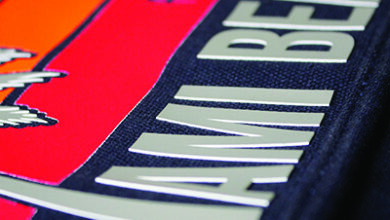To me, there are only two drawbacks to sublimation: the lack of white ink in the process and the fact that sublimation ink only transfers and bonds to polyester. But with some creativity, you can easily overcome them in your decorating business.
The lack of white ink means the best shirt for sublimation is going to be a white shirt because it offers a good base to put colors on. A white shirt won’t affect the look of those colors. If I’m printing a blue image onto a yellow shirt, the blue image ends up green on yellow. If you have nice white, puffy clouds in your image and you print onto a light blue shirt, those clouds turn out as light blue puffy clouds. This means I can’t really create black shirts, but there are some tricks. If I print black ink onto a red shirt, that will work, but yellow onto that same red shirt will barely show up. The only way around it is to start with a white shirt and imprint the entire front and back. Many people do so onto shirt panels and then sew them together after decorating.
The second restriction of sublimation is the ink doesn’t transfer into the molecules of cotton as the inks only transfer to polyester. For example, if you are decorating a 50/50 shirt, it only bonds to the polyester portion, which might actually look somewhat decent on that first print. However, after it gets washed for the first time, that ink that’s just sitting on the top of the cotton is going to wash out. The ink will never wash out of the polyester side. So, if I’m doing a 100 percent polyester shirt, it’s going to remain the same after one wash or after 1,000 washes. The more polyester content you have in the garment, the more pop and vibrancy your image will have.
There are some sub transfers sold in the marketplace that claim to be sublimatable onto cotton. While they are becoming better and better, my disclaimer is that it’s not true sublimation. You’re still putting something on top of the garment rather than making it part of the cotton.
—MontCo Consulting



